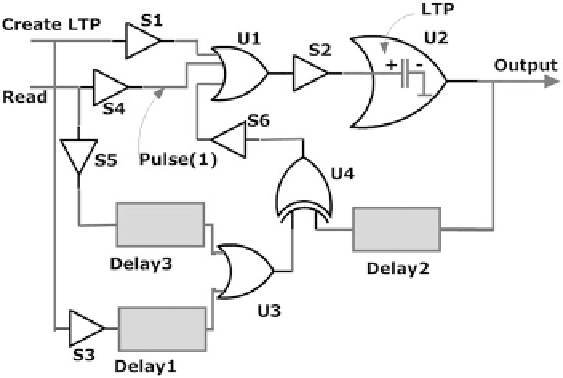Information Technology Reference
In-Depth Information
Fig. 4.4
Hybrid long-term memory (S4, S5 weak synapses)
Hybrid Circuit
LTP and recursive circuitry may be combined, and may very well have evolved to
provide certain physical advantages, including instant memorization when
conditions are right, and memory signals that shut off after a few seconds to
conserve energy, but which are easily reactivated. A proposed circuit is illustrated
in Fig.
4.4
. Note that the physical neural circuitry is fairly simple, but that circuit
models often show many technical details including delays.
LTP is created to reside in U2, so that it responds to a single pulse. The signal for
its creation flows from S1, U1, and S2. However, the path S3, Delay1, and U3
presents a pulse to dendritic XOR gate U4 whose purpose is to prevent a circulating
pulse from being initiated. Delay1 is such that when the two pulses, one recycling
from Delay2 and one from U3 meet at about the same time, they give no output
from the XOR. So LTP is instilled but with no circulating pulse.
Upon query, if and only if LTP is in U2, multivibration is triggered by a read
signal. Note that the query is produced by a weak synapse S4 to have only a single
pulse. By the way, the frequency of multivibration is controlled by Delay2.
But the circulating pulse is stopped eventually by a pulse along the path weak
synapse S5, Delay3, and U3 to the XOR. Delays3 is such that a prescribed number
of cycles through U2 occur but that at some point a pulse emerges from Delay3 and
thus from U3. The XOR does not permit an output when two pulses occur simulta-
neously at the input. The plan is that recursive memory now goes to sleep until
triggered by the next query.
This circuit does not take advantage of back propagations. In fact, back
propagations are suppressed, and do no harm, by having regular synapses at the
inputs of the OR gates.

Search WWH ::

Custom Search